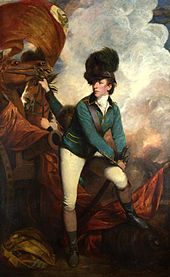Waxhaw massacre
Waxhaw Massacre is an alternate term for the Battle of Waxhaw , which took place in Lancaster , South Carolina on May 29, 1780 during the American Revolutionary War . Patriots under Abraham Buford and the predominantly loyalist troops under Banastre Tarleton were involved in the battle .
background
Colonel Abraham Buford led a troop of 350 to 380 men of the third unit of the Virginia Continental Army , consisting of the 7th Virginia Regiment, two companies of the 2nd Virginia Regiment and one artillery unit with two six-pounders to South Carolina to the siege of Charleston to support. Before they even arrived, they learned that the city had already been conquered by the British and returned to Virginia.
British Colonel Banastre Tarleton heard that the patriotic governor of South Carolina, John Rutledge , was traveling with Buford. Eager to take this prisoner, Tarleton took up the chase with a force of almost 230 men. This force consisted of 130 dragoons , 100 mounted infantry of the British Legion and a three-pounder. Only a 60-man detachment of the 17th Light Dragoons and the Legion's cavalry , 60 mounted infantry, and a flanking group of 30 dragoons with a few infantrymen were involved in the attack itself .
Course of the battle
On May 29, 1780, Tarleton caught up with Buford in the Waxhaws, the border area between North and South Carolina, at an intersection in what is now Buford . Rutledge had already left the patriotic department by that time. While Tarleton waited for his reserve units to catch up with him, he sent Captain David Kinlock to Buford to demand his surrender. In his message, he exaggerated his troop strength and claimed to have 700 men with him to influence Buford's decision. Buford responded with the message:
"I reject your proposals, and shall defend myself to the last extremity."
"I reject your suggestions and will defend myself to the last."
Regardless, Buford chose to keep marching instead of preparing for battle. When the attack came, Buford waited until Tarleton's men were within 10 meters before giving the order to fire. This had minimal effect on the attacking cavalry and resulted in a devastating defeat for the Virginians. According to the Tarleton battle report, 113 men fell on the side of the patriots, 147 were wounded and released on word of honor, the cannons and 26 transport carts were captured by the British. The British lost 5 men, 12 were wounded, while 11 horses were killed and 19 injured.
Consequences of the battle
The battle was always hotly debated, as the men of Tarleton had slaughtered many of the patriots with their sabers after breaking the Buford lines. Some sources, such as Buford's aide Henry Bowyer and surgeon Brownfield, state that Buford had already raised the white flag , but Tarleton ignored it. According to Tarleton's own report, although he admits the massacre, he claims his horse was shot under him and because his men believed him dead, this outbreak of violence occurred. A member of the British Army, surgeon Robert Brownfield, however, wrote that Tarleton was involved in the carnage.
The wounded on both sides, however, were treated equally well by the British. The American officers and men unable to travel were released the next morning and housed in neighboring plantations not far from the battlefield. Additional surgeons were called in from Camden and Charlotte, and every possible help was given to the Patriots by the British.
Before the massacre, it was believed that the southern states would not support the patriotic cause and would loyally stand by the British. However, according to reports from Waxhaw, the direction of the war in the south appeared to be changing. Many who were more neutral on the question of independence then turned to the patriots. The shouts “Tarleton's Quarter!” And “Remember Buford” became war cries of the patriots, the massacre itself triggered the march of the Overmountain Men over the Appalachians to the battlefield at Kings Mountain , who were partly responsible for the destruction of Major Patrick Ferguson's troops .
Web links
- Louise Pettus: The Buford Massacre of May 9, 1780
- Banastre Tarleton and the British Legion
- The Real Story of the American Revolution: Account of the Waxhaw Massacre (PDF; 207 kB)
Coordinates: 34 ° 44 ′ 31 ″ N , 80 ° 37 ′ 32.9 ″ W.


